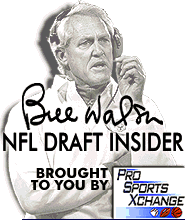
How I Evaluate Each Position:
Outside Linebacker
By Bill Walsh
PSX Draft Insider Special
|
|
How I Evaluate Each Position: Outside Linebacker By Bill Walsh PSX Draft Insider Special |
OUTSIDE LINEBACKER
Ideal size: 6-3, 245
There are several types of outside linebackers. I will break them down into the weak outside linebacker, which itself has two categories, and the strong outside linebacker.
On the so-called weak side, there are two distinct categories -- the pass rusher and the pursuit-coverage linebacker. There are very few who have a high degree of effectiveness at both.
The pass rush type was best defined by Lawrence Taylor during his great years with the New York Giants. He was the greatest. In the 1990s, there has been Derrick Thomas of the Kansas City Chiefs, although his ability against the run isn't on a par with L.T.'s.
But the outside linebackers in a pass rush combination of 3-4 style defense have taken the place of the defensive end. There has been a trend away from the 3-4 in the past few years, but these things tend to be cyclical, often dependent upon personnel. But this pass rushing, outside linebacker is going to have help right next to him in the 3-4 defense and he can take latitude in the pass rush. They can work that much harder at beating the offensive tackle at the line of scrimmage with quickness because they do have help.
The pass rush combination guy is going to be primarily a pass rusher and then a run defender. He is a zone drop defender. Rarely will he cover man to man because coaches should not ask him to. That profile is of the quickest, fastest, large enough man to play this position. He can sell out as long as he works in relationship with the defensive end in combination.
These pass rushing outside linebackers must have natural gifts, or instincts for dealing with offensive tackles who are up to 100 pounds heavier. Quickness is only part of it. They must know how to use leverage, how to get underneath the larger man's pads and work back toward the quarterback. And he must be strong enough to bounce off blocks and still make the play.
The other type of weak outside linebacker would be a combination of a lateral pursuit guy against running plays and man or zone pass coverage. You need an excellent pass coverage and pursuit man. Because he is on the weak side and is not primarily a pass rusher, he must be able to function in space. Yet when he does pursue he can't get knocked around by blockers. He has to have enough strength to go across the face of a lineman to get to the ball.
Now we also have the strong side linebacker, who plays opposite the tight end. He should be larger than the weak side outside linebacker, about 6-4, 250. He must have the hands and the range to hold up the tight end and to wade through the fullback, or whoever is blocking, to get to the ball. This strong side linebacker must be able to hold the edge of the defense.
He must be able to hold up the tight end. He can meet the fullback's block. He can blitz effectively against running backs attempting to pass protect him. And he can meet the off tackle play of the fullback or the pulling guard. This position is not as common as it once was. Now they are shifting the line so a defensive lineman is over the tight end and the linebacker is stacked behind.
But it is still the same type of athlete. He typically plays on the tight end side and he is bigger and stronger. In the past he has not had to be a key coverage guy. But now if he is stacked behind a defensive lineman and protected, he becomes a key coverage man.
Even with the changes in philosophy, teams are flopping their outside linebackers. They have a pursuit linebacker and a run defender.